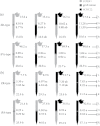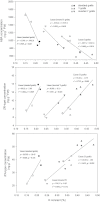Mechanism of phytohormone involvement in feedback regulation of cotton leaf senescence induced by potassium deficiency
- PMID: 22962680
- PMCID: PMC3467299
- DOI: 10.1093/jxb/ers238
Mechanism of phytohormone involvement in feedback regulation of cotton leaf senescence induced by potassium deficiency
Abstract
To elucidate the phytohormonal basis of the feedback regulation of leaf senescence induced by potassium (K) deficiency in cotton (Gossypium hirsutum L.), two cultivars contrasting in sensitivity to K deficiency were self- and reciprocally grafted hypocotyl-to-hypocotyl, using standard grafting (one scion grafted onto one rootstock), Y grafting (two scions grafted onto one rootstock), and inverted Y grafting (one scion grafted onto two rootstocks) at the seedling stage. K deficiency (0.03mM for standard and Y grafting, and 0.01mM for inverted Y grafting) increased the root abscisic acid (ABA) concentration by 1.6- to 3.1-fold and xylem ABA delivery rates by 1.8- to 4.6-fold. The K deficiency also decreased the delivery rates of xylem cytokinins [CKs; including the zeatin riboside (ZR) and isopentenyl adenosine (iPA) type] by 29-65% and leaf CK concentration by 16-57%. The leaf ABA concentration and xylem ABA deliveries were consistently greater in CCRI41 (more sensitive to K deficiency) than in SCRC22 (less sensitive to K deficiency) scions under K deficiency, and ZR- and iPA-type levels were consistently lower in the former than in the latter, irrespective of rootstock cultivar or grafting type, indicating that cotton shoot influences the levels of ABA and CKs in leaves and xylem sap. Because the scions had little influence on phytohormone levels in the roots (rootstocks) of all three types of grafts and rootstock xylem sap (collected below the graft union) of Y and inverted Y grafts, it appears that the site for basipetal feedback signal(s) involved in the regulation of xylem phytohormones is the hypocotyl of cotton seedlings. Also, the target of this feedback signal(s) is more likely to be the changes in xylem phytohormones within tissues of the hypocotyl rather than the export of phytohormones from the roots.
Figures









Similar articles
-
Cotton shoot plays a major role in mediating senescence induced by potassium deficiency.J Plant Physiol. 2012 Mar 1;169(4):327-35. doi: 10.1016/j.jplph.2011.10.009. Epub 2011 Dec 9. J Plant Physiol. 2012. PMID: 22154601
-
Effects of cotton rootstock on endogenous cytokinins and abscisic acid in xylem sap and leaves in relation to leaf senescence.J Exp Bot. 2008;59(6):1295-304. doi: 10.1093/jxb/ern035. Epub 2008 Mar 28. J Exp Bot. 2008. PMID: 18375935
-
Rootstock-mediated changes in xylem ionic and hormonal status are correlated with delayed leaf senescence, and increased leaf area and crop productivity in salinized tomato.Plant Cell Environ. 2009 Jul;32(7):928-38. doi: 10.1111/j.1365-3040.2009.01973.x. Epub 2009 Mar 3. Plant Cell Environ. 2009. PMID: 19302168
-
Omics of root-to-shoot signaling under salt stress and water deficit.OMICS. 2011 Dec;15(12):893-901. doi: 10.1089/omi.2011.0092. Epub 2011 Dec 2. OMICS. 2011. PMID: 22136663 Review.
-
Long-distance signalling of abscisic acid (ABA): the factors regulating the intensity of the ABA signal.J Exp Bot. 2008;59(1):37-43. doi: 10.1093/jxb/erm127. Epub 2007 Jun 26. J Exp Bot. 2008. PMID: 17595196 Review.
Cited by
-
Maize Dek33 encodes a pyrimidine reductase in riboflavin biosynthesis that is essential for oil-body formation and ABA biosynthesis during seed development.J Exp Bot. 2019 Oct 15;70(19):5173-5187. doi: 10.1093/jxb/erz268. J Exp Bot. 2019. PMID: 31173102 Free PMC article.
-
Physiological controls of chrysanthemum DgD27 gene expression in regulation of shoot branching.Plant Cell Rep. 2016 May;35(5):1053-70. doi: 10.1007/s00299-016-1938-6. Epub 2016 Feb 16. Plant Cell Rep. 2016. PMID: 26883225
-
HECATE2 acts with GLABROUS3 and Tu to boost cytokinin biosynthesis and regulate cucumber fruit wart formation.Plant Physiol. 2021 Nov 3;187(3):1619-1635. doi: 10.1093/plphys/kiab377. Plant Physiol. 2021. PMID: 34618075 Free PMC article.
-
CsIAGLU Regulates the Angle of Leaf Petiole by Affecting Endogenous Content of Auxin in Cucumber (Cucumis sativus L.).Genes (Basel). 2022 Nov 25;13(12):2216. doi: 10.3390/genes13122216. Genes (Basel). 2022. PMID: 36553483 Free PMC article.
-
Global transcriptome analysis of the maize (Zea mays L.) inbred line 08LF during leaf senescence initiated by pollination-prevention.PLoS One. 2017 Oct 3;12(10):e0185838. doi: 10.1371/journal.pone.0185838. eCollection 2017. PLoS One. 2017. PMID: 28973044 Free PMC article.
References
-
- Albacete A, Martinez-Andujar C, Ghanem ME, Acosta M, Sanchez-Bravo J, Asins MJ, Cuartero J, Lutts S, Dodd IC, Pérez-Alfocea F. 2009. Rootstock-mediated changes in xylem ionic and hormonal status are correlated with delayed leaf senescence, and increased leaf area and crop productivity in salinized tomato Plant, Cell and Environment 32 928–938 - PubMed
-
- Bednarz CW, Oosterhuis DM. 1995. Plant potassium partitioning during progression of deficiency symptoms in cotton (Gossypium hirsutum). Better Crops Potash and Phosphate Institute 79 12–14
-
- Beveridge CA, Murfet IC, Kerhoas L, Sotta B, Miginiac E, Rameau C. 1997. The shoot controls zeatin riboside export from pea roots. Evidence from the branching mutant rms4 The Plant Journal 11 339–345
-
- Buchanan-Wollaston V, Page T, Harrison E, Breeze E, Lim PO, Nam HG, Lin JF, Wu SH, Swidzinski J, Ishizaki K, Leaver CJ. 2005. Comparative transcriptome analysis reveals significant differences in gene expression and signalling pathways between developmental and dark/starvation-induced senescence in Arabidopsis The Plant Journal 42 567–585 - PubMed
Publication types
MeSH terms
Substances
LinkOut - more resources
Full Text Sources
Medical
Research Materials
Miscellaneous

